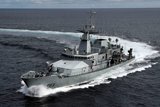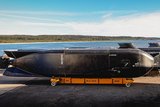Combat system concentration for Lockheed Martin after FFG(X) withdrawal
Following the decision by Lockheed Martin to withdraw from the US Navy’s FFG(X) process, the company will focus its efforts on the programme’s future combat systems, while also working to build up the capabilities of the Freedom-class Littoral Combat Ships (LCS) (pictured) on which its offering was designed.
On 29 May, USNI News reported the company’s intention to remove itself from the competition.
In February 2018, the navy awarded 16-month conceptual design contracts, valued at $15 million each, for the frigate to five companies: Austal USA, General Dynamics Bath Iron Works, Huntington Ingalls Industries, Lockheed Martin and Marinette
Already have an account? Log in
Want to keep reading this article?
More from Naval Warfare
-
![Canadian Coast Guard’s OOSV delivery is “major milestone” in fleet modernisation]()
Canadian Coast Guard’s OOSV delivery is “major milestone” in fleet modernisation
The Polar Class 6 platform is the largest CCG science-dedicated vessel and will operate on the country’s east coast.
-
![How the Anduril-HHI autonomous ship plan fits in with the US Navy’s MASC programme]()
How the Anduril-HHI autonomous ship plan fits in with the US Navy’s MASC programme
The new modular vessel is expected to be developed for both commercial and defence use, with a heavy focus on production speed and mission flexibility.
-
![Indo Pacific 2025: Autonomous systems reigned but can the Australian Defence Force afford it?]()
Indo Pacific 2025: Autonomous systems reigned but can the Australian Defence Force afford it?
Multiple autonomous systems and technologies were on display at this year’s Indo Pacific, but questions remain over how the Australian Department of Defence will balance the books.
-
![How the UK Royal Navy is powering up its hybrid fleet to combat new threats]()
How the UK Royal Navy is powering up its hybrid fleet to combat new threats
Since it announced its move towards a new “hybrid navy” earlier this year, the force has announced a number of new uncrewed technologies in the works.
-
![US and UK to begin Trident II D5 Increment 8 in October 2026]()
US and UK to begin Trident II D5 Increment 8 in October 2026
Trident II D5 Increment 8 will involve improvements to the shipboard navigation subsystem for the US Ohio and Columbia and the UK Dreadnought and Vanguard submarine classes.






















